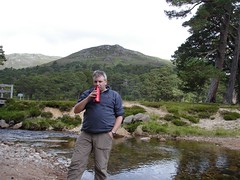Here's the reference that Pharmolo at Northern Trip sourced.
Source: Press and Journal, Saturday 17 February 2007
The Uk Government could face a multimillion-pound fine if Scottish ministers allow plans for a massive windfarm on the Western Isles to go ahead, the Royal Society for the Protection of Birds warned yesterday.
It believes the Lewis Wind Power application for 181 turbines was made without a proper environmental impact assessment.
That, it says, would contravene the European Habitats Directive.
Western Isles councillors voted 18-8 in favour of the £512million windfarm development on Thursday.
But local RSPB spokesman Martin Scott said: "From what we have seen in the council's report, they haven't even considered any of the European law or European designations. The whole process that the council seems to have followed does appear to be flawed.
"I'd like to think that the Scottish Executive would pick up on it. I suspect that the European Union aren't going to be particularly pleased that somebody has just tried to consent a large-scale industrial development on prime wildlife sites in breach of the Habitats Directive. We've always said it would likely end up in Brussels. It's heading there at a rapid pace now."...
LWP director David Hodkinson said: "The RSPB is well versed in the application of European law to major infrastructure developments, including the Thames estuary offshore project, which they welcomed a few months ago as the UK's first major windfarm to have been consented in a European special protection area.
"They are also advising on the Viking windfarm development in Shetland, which, we suggest, they know will need to be considered as a special protection area before the windfarm can be consented because of its significant bird interests.
"So we suggest they know that the Lewis windfarm could only go ahead in compliance with European law. It simply would not be consented otherwise.
"To suggest anything different would appear to be yet another example of the RSPB relying on the selective use of the facts to challenge our development. In our opinion, this is a clear sign that the RSPB's campaign against the Lewis windfarm has run out of scientific arguments."
I'll stand by my original comment, and read all the references to habitat management in the CNES terms.
Objections on the grounds of the EU Directives were lodged with the Comhairle in the RSPB media release of 2 Feb 2007 [source].
So, to say that the "This was also not spotted by WIC", is wrong. The Comhairle were well informed of this before they made their decision on Thursday 15 Feb 07. The RSPB are quoted in this BBC report of Friday 16 Feb 07:
The RSPB said the Lewis wind farm threatened habitats and bird-life of European significance.
However, developers claimed that even after construction the project would create 70 ongoing operating and maintenance jobs.
Jobs before birds, was the quote given elsewhere in the media.
And not to dash anyone's hopes, but here is how Lewis MacDonald MSP dealt with similar (but not identical) objections back in 2002 from Linda Fabiani :
Linda Fabiani (Central Scotland) (SNP): To ask the Scottish Executive what consultation has taken place with the European Commission with regard to the proposed wind farm at Whitelees Forest and the effects on the six bird species which Scottish Power has confirmed are present on Eaglesham Moor, given that the birds’ priority habitat or species is defined in Article 1 of the European Habitats Directive and are listed under EC directive 79/409/EEC as needing special protection.
(S1W-28165)
Lewis Macdonald: There is no requirement on the Scottish Executive to consult the European Commission on this issue since the area is not designated as being of national or international importance for bird species or habitats. Scottish Natural Heritage was among the bodies consulted about the environmental impact of the proposed wind farm and has welcomed the developer’s proposal to put in place a Habitat Management Plan with the aim of enhancing the existing peatland habitat across the moor, which they believe should contribute towards the offsetting of any local adverse impact.
Source: Written Answers, Scottish Executive, 30 August 2002.
And finally, here's a quote from the Sunday Times:
Last week Lewis Wind Power (LWP), a joint venture between Amec and British Energy, submitted revised plans to the Scottish executive for the £500m project, reducing the number of turbines from 234 to 181 to lessen the impact on wildlife.
The company said it had restricted the search for sites to the Outer Hebrides because one of the primary aims of the project was to provide social and economic benefits to the islands.
The plans are now being scrutinised by the European commission.
The Sunday Times has learnt that officials in Brussels believe that the company must assess other possible locations across Scotland to comply with the habitats directive, which demands that other sites are considered when species and protected tracts of land are threatened by development.
But the article was dated 17 December 2006, and has anyone asked the EU about their scrutinisation of the plans? Perhaps someone could ask Elspeth Attwooll MEP, to ask who exactly is scrutinising it in Brussels, and did no-one think to pass the information to the CNES before Thursday's meeting?
Democracy rules!
 Getting on with my life and thinking about things.
Getting on with my life and thinking about things.










4 comments:
Well done on the research, Aktoman. I'm still not convinced, but it will require a legal expert to establish whether or not all requirements under European law have been met. The way I read it, they have not.
I foresee a lively discussion on various forums on this issue this week.
Facts need to be available. I heard the "Today" programme on Radio 4 on Friday, and both parties were being interviewed. MWT and LWP. MWT talked about the lack up public consultation (following on from the court case on Thursday re nuclear power); and LWP talked about halting declining school rolls (IIRC). Not exactly a lively discussion.
But then politics isn't about discussion any more. It is about one side being right and the other being wrong. Completely wrong. Humiliated and hung out to dry. Maybe that is the fault of the media, or was it Thatcher that showed that discussion and compromise were signs of political weakness?
BTW: if this does get thrown out because of CNES ignoring the facts presented to them by the RSPB, then hopefully the taxpayer will not be left footing the bill for things that went ahead when they should not have.
You might be interested in the campaign information at:
http://www.ramblers.org.uk/scotland/elections.html
I'm just too cynical when I see that Scottish Power Renewables are sponsoring the Girvan Cycle Race. Which will take the cyclists past a wind factory.
http://www.girvanrace.info
Maybe it is a pretty one that isn't a blight on the landscape? I hope it looks pretty.
Post a Comment